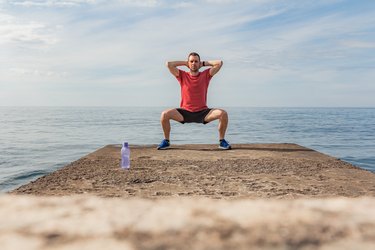
Pop quiz: Name an animal with strong, powerful legs.
Maybe you chose the swift, graceful gazelle. Or perhaps the speedy cheetah with its explosive strides. Chances are you didn't pick the platypus — the odd-looking otter-type creature with a duck-like bill and short, stubby limbs.
Video of the Day
While the platypus may not boast the best gams in the animal kingdom, it does lend its moniker to an amazingly effective leg exercise. Platypus walks — which involve coming into a deep sumo squat and walking forward and backward — are aptly named because they imitate the signature waddle of the water animal on land.
Sure, the move may look a little funny, but this wide-legged waddle seriously builds your leg and glute muscles while stretching your hips. Plus, it's low impact (read: kind to your joints and safe for most people), requires no equipment and takes up very little space (meaning you can do them just about anywhere).
The platypus walk exercise is also extremely versatile: "Platypus walks could be incorporated as a warm-up to your workout, utilized as cardio or in a strength-training session (especially with the addition of ankle weights)," says Joilan Lewis, CPT, a certified personal trainer at LifeTime.
If you're ready to get stronger with every step and are looking for a legit lower-body burn, add platypus walks to your workout plan, ASAP.
How to Do Platypus Walks
- Start in a wide stance with your knees and feet turned outward.
- Bend your knees, coming into a deep sumo squat, and place your hands behind your head.
- Maintaining the squat position, take four steps forward.
- Take four steps backward.
- Make sure your thighs are parallel to the ground (or as low as you can comfortably go while maintaining proper form), your knees are stacked on top of your ankles and your weight is in your heels.
- Continue for 40 seconds, moving as quickly as you can with good form.
4 Reasons to Do Platypus Walks Every Day
Here are just a few reasons you should incorporate platypus walks into your daily routine:
1. They Activate Your Glutes
While you may feel weird in the wide-legged waddle position, this strange stance is key for targeting the largest muscle group in your body: your glutes.
"The glutes are activated when the hips externally rotate, knees are laterally rotated and the pelvis is rotated backward [anterior pelvic rotation] — all of which are incorporated when performing the platypus walk," Lewis says.
2. They Strengthen Your Quads
During platypus walks, you remain in a squatted stance the whole time. Translation: Your thighs never get a break. "The prolonged squatting position puts the quadriceps under tension for an extended period, resulting in hypertrophy," Lewis says. In other words, the time under tension helps you build strong leg muscles.
3. They Stretch Your Hips
Platypus walks are the perfect antidote for all the sitting you do every day, which shortens and tightens your hip flexors.
Once again, the secret to the platypus walk's power is its wide, waddle-like stance. With your knees and feet turned outward, the move requires an exaggerated external rotation of the hips. This external hip rotation helps adequately lengthen and stretch the muscle fibers attached to the iliac crest — i.e., the hip bone — Lewis says.
Not only will your loose, limber hips thank you, but your lower back will, too. Tightness in your hips often leads to tension and pain in your low back.
4. They’re Low Impact
Low-impact exercises like platypus walks are gentler on the joints. "The wider stance of the platypus walks makes it a hip-dominant movement, thus relieving stress off the knees," Lewis says.
While platypus walks are low impact, they can still be high intensity — especially if you move fast. Putting some pep in your platypus step will definitely get your heart rate up. Just be careful to keep correct form — you should never sacrifice proper technique for speed.